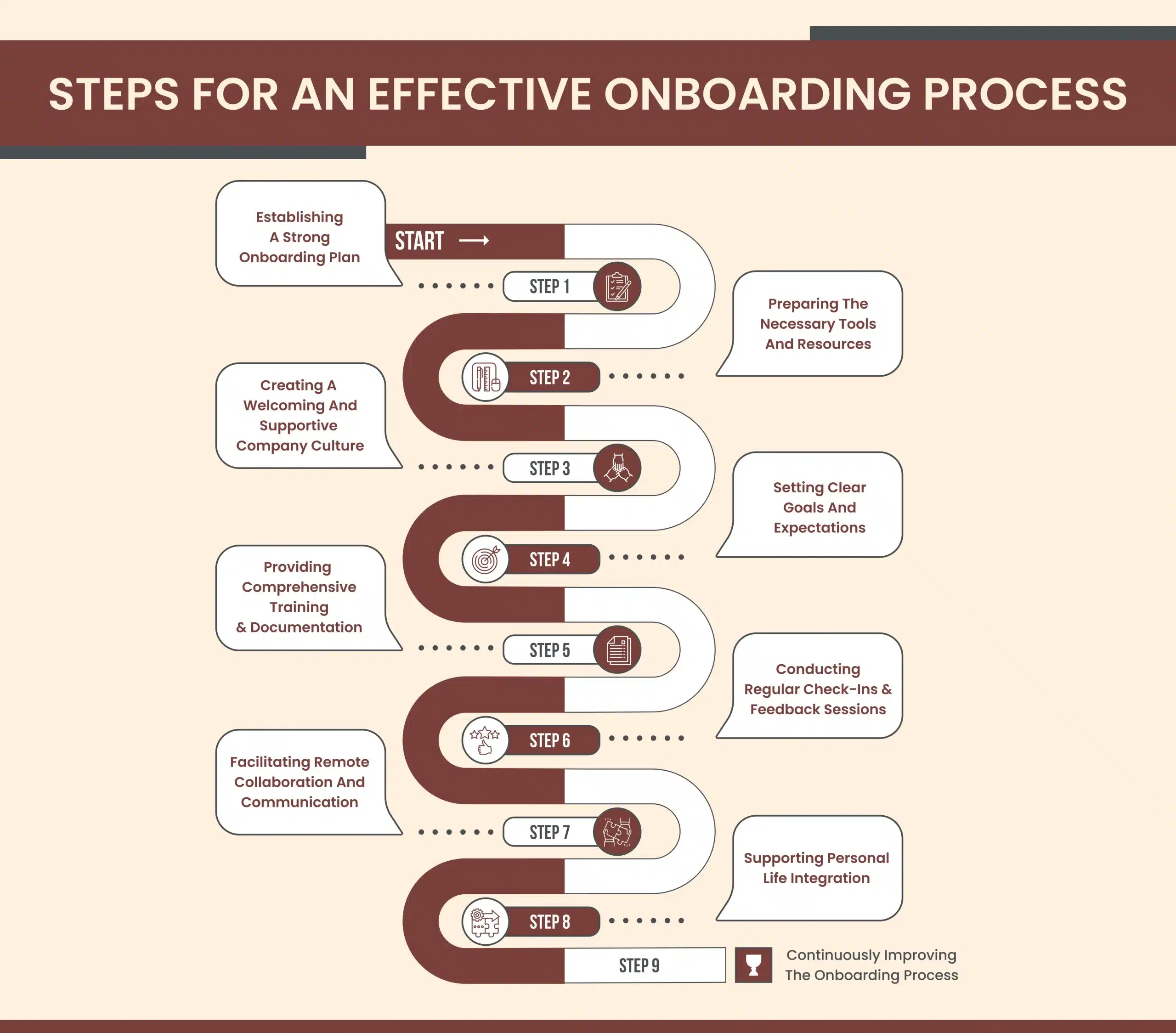Table of content
Are you struggling to effectively onboard remote developers? Don’t worry, you’re not alone. With the rise of remote work, it has become essential for businesses to establish an effective onboarding process for remote developers. Otherwise, it can lead to miscommunication, confusion, and even dissatisfaction among team members.
In this comprehensive blog, we will walk you through the 10 key steps for a seamless onboarding process specifically tailored for remote developers. We’ll address common pain points and provide practical tips, strategies, and best practices to help you build a strong foundation for your remote team.
Steps for an Effective Onboarding Process
From pre-boarding preparations to fostering effective communication, managing expectations, and promoting team collaboration, we’ve got you covered. Let’s dive in and discover how to make the onboarding process not only efficient but also enjoyable for your remote developers.
Establishing a Strong Onboarding Plan
In ensuring a smooth integration of remote developers, crafting a robust onboarding plan is pivotal. Your success lies in adhering to these steps, paving the way for an effective process that nurtures engagement, productivity, and a positive newcomer experience.
Start by setting clear objectives and expectations. Outline roles, responsibilities, and deliverables, providing a transparent roadmap for your new hire within the team. Equip them with essential tools and resources, ensuring seamless job performance. Foster alignment with company culture by introducing values, mission, and vision through presentations or virtual team-building activities.
Preparing the Necessary Tools and Resources
To guarantee an effective onboarding process for remote developers, ensure all necessary tools and resources are ready. Begin by identifying required software and licenses, compiling a comprehensive list that encompasses project management tools, version control systems, code editors, and specialized software. Ensure licenses are acquired and ready for activation before the new developer’s arrival. Set up remote access, providing secure login credentials and clear instructions for accessing the company’s systems, servers, and databases.
Create a central documentation repository, offering guidelines and relevant resources in an organized, user-friendly manner. Ship or provide necessary hardware equipment, ensuring it’s configured and tested to prevent technical glitches. Establish communication channels for seamless collaboration, including integrated chat platforms, video conferencing tools, and project management software. Share login information and provide an overview of each channel’s use.
Creating a Welcoming and Supportive Company Culture
Creating a welcoming and supportive company culture is vital for a smooth and effective onboarding process for remote developers. This foundation ensures new team members feel valued, included, and ready to contribute effectively. To foster collaboration, growth, and a sense of belonging, communicate core values and the company’s mission clearly. Pair new developers with experienced team members to navigate their roles and the remote work environment effectively, fostering guidance and support.
Demonstrate commitment to professional growth by offering learning opportunities such as online courses or workshops. Celebrate achievements, whether project milestones or personal goals, as recognition and appreciation contribute significantly to fostering a positive company culture. This holistic approach creates an environment where remote developers thrive and contribute effectively.
Setting Clear Goals and Expectations
To establish a seamless onboarding process for remote developers, it’s crucial to set clear goals and expectations, providing a foundation for understanding roles and fostering purpose from day one. Begin by defining role-specific goals, outlining objectives, deadlines, and milestones. This clarity establishes a pathway for success, allowing developers to align their efforts effectively. Aligning individual goals with overall company objectives instills motivation, emphasizing how their role contributes to the larger picture and fostering a sense of collective effort within the remote team.
Communicate performance metrics by establishing key performance indicators (KPIs) and providing regular feedback based on these metrics. This clarity enables developers to understand how their work will be evaluated and track progress towards meeting targets. Be transparent about potential challenges, including the learning curve and remote work environment, setting realistic expectations to manage workloads and provide necessary support for success.
Providing Comprehensive Training and Documentation
Ensuring a seamless transition for new remote developers involves a comprehensive training approach. Begin with a thorough orientation session, acquainting them with the company’s mission, values, and culture to set clear expectations. Tailor technical training to their role, covering coding standards, software architecture, and relevant tools through digestible modules and hands-on exercises.
Craft a comprehensive onboarding package containing a developer handbook, coding guidelines, and internal process documentation for quick access. Encourage collaborative projects to apply acquired skills and understand project management processes within the remote work environment.
Highlight the significance of documentation for knowledge sharing and transparent communication. Emphasize contribution to documentation for innovative solutions. Extend support beyond onboarding with continuous resources like training sessions and online forums, fostering a collaborative and supportive environment for ongoing growth and development among remote developers. This holistic approach ensures a positive and productive onboarding experience.
Conducting Regular Check-ins and Feedback Sessions
Regular check-ins and feedback sessions play a crucial role in ensuring a successful onboarding process for remote developers. These practices establish open and transparent communication, reinforcing the new team member’s sense of support and value. To effectively conduct these sessions, schedule consistent meetings at predetermined intervals, creating a routine for expectation. Foster a safe and non-judgmental environment during check-ins, encouraging the developer to share thoughts, challenges, and accomplishments. Prepare a focused agenda before each meeting, covering topics like project updates, challenges, goals, and growth opportunities.
Use these sessions for constructive feedback, providing specific examples for improvement while highlighting strengths. Encourage self-reflection, prompting the new developer to identify areas for additional support or training and set personal goals. Emphasize continuous learning, recommending relevant resources for professional development, and fostering a culture of knowledge-sharing within the team. Address concerns promptly, demonstrating commitment to their success and maintaining a positive onboarding experience.
Facilitating Remote Collaboration and Communication
In the digital era, effective remote collaboration and communication are pivotal for the success of onboarding, especially for remote developers. Ensure a seamless flow of information and foster teamwork for your new team member. Begin by introducing the remote developer to the team, providing comprehensive details for connections. Set up transparent communication channels.
Create a centralized repository for documentation, project guidelines, and best practices, encouraging contributions from team members. Implement collaborative tools such as version control systems and virtual whiteboards. Cultivate a supportive culture valuing collaboration, feedback, and knowledge sharing. Establish a process for regular feedback and performance evaluations, setting clear expectations for growth. Encourage social interaction, fostering casual conversations and virtual team-building activities. Mindfully address time zone differences when scheduling meetings.
Supporting Personal Life Integration
Remote work offers a unique opportunity for developers to seamlessly blend personal and professional aspects of life. Consider the individual’s personal life in the onboarding process with these supportive measures. Acknowledge time zone differences and personal commitments by introducing flexible working hours. Emphasize the importance of work-life balance, encouraging developers to set boundaries and prioritize self-care. Provide clear remote work guidelines on availability and communication channels, ensuring transparent communication. Encourage self-care practices, sharing resources for maintaining a healthy work-life balance and managing stress.
Continuously Improving the Onboarding Process
For a company dedicated to excellence, continuous improvement of the onboarding process for remote developers is paramount. By consistently evaluating and refining your approach, you ensure seamless transitions and effective integration into your team. Begin by setting clear expectations, communicating roles and responsibilities clearly to align with organizational goals. Facilitate collaboration through virtual meetings and project tasks, encouraging knowledge sharing and camaraderie. Cultivate company culture, communicating values, recognizing achievements, and organizing virtual events. Regularly gather feedback to identify and enhance the onboarding experience for remote developers.
Conclusion
In conclusion, implementing an effective onboarding process for remote developers is crucial for optimizing your team’s performance and elevating productivity. By following the steps outlined in this blog, you can ensure a smooth transition for new developers, setting them up for success from day one. Firstly, prioritize clear communication and establish expectations to foster a strong remote working culture. Secondly, provide comprehensive documentation and resources to facilitate self-learning and independent problem-solving. Thirdly, leverage collaboration tools and regular check-ins to maintain team cohesion and support. Additionally, personalizing the onboarding experience and assigning mentors can help remote developers feel supported and valued. Investing in a robust training program and continuously seeking feedback will further enhance their growth and engagement. In conclusion, creating success.










